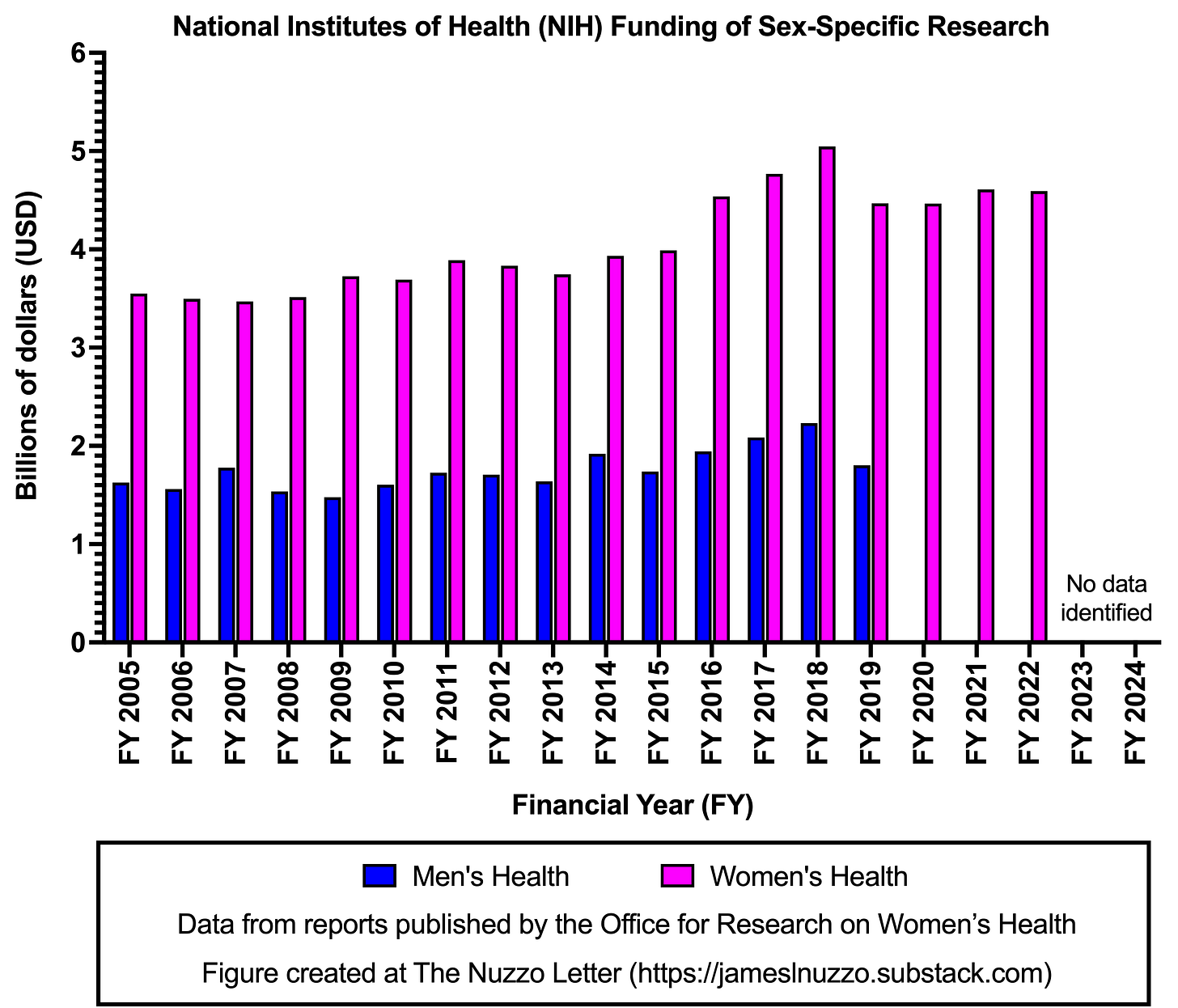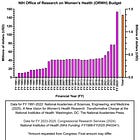This week’s graphs update previous graphs published at The Nuzzo Letter that show the amount of money that the United States (U.S.) National Institutes of Health (NIH) expends on sex-specific research. This update pertains to historical data (1988-2004) that were not known to me at the time I created the previous graphs. Nevertheless, data from the past five years, particularly regarding men’s health funding, remain elusive. This elusiveness is due to changes in reporting practices from the NIH and its Office of Research on Women’s Health (ORWH).
Proportion of NIH Funding for Men’s and Women’s Health Research
The vast majority of the NIH’s research budget is not sex-specific. Each year since 1998, the NIH has invested approximately 75% to 85% of its research budget into projects that are not sex-specific.
Averaged across all years from 1998 to 2019, 81% of the NIH’s research budget has been invested in research that is not sex-specific.
Of NIH funding that has been allocated to sex-specific research, significantly more funds have been allocated to women’s than men’s health. Between 1998 and 2019, 10% to 16% of the NIH’s research budget was invested in women’s health, whereas 4.5% to 7.5% was invested in men’s health.
Averaged across all years from 1998 to 2019, 13% of the NIH’s research budget was invested in women’s health, whereas 6% was invested in men’s health.
Absolute Amount of NIH Funding for Men’s and Women’s Health Research
Between 2005 and 2019, research funding from the NIH that has not been sex-specific has ranged from $22 to $32 billion per year (top graph below).
Between 2005 and 2022, the amount invested by the NIH into women’s health ranged from $3.5 to $5 billion per year (top and bottom graphs below). The average investment into women’s health research across this time was $4.1 billion per year.
Between 2005 and 2019, the amount invested by the NIH into men’s health ranged from $1.5 to $2.2 billion per year (top and bottom graphs below). The average investment into men’s health research across this time was $1.8 billion per year. Thus, the NIH consistently invested over two times more money into women’s than men’s health research over this time.
Sources
Data from FY 1988-2004 were acquired from Drye LT, Meinert JL, Meinert CL. Gender indexing in publications of clinical trials: 1991-2008. Clinical Trials. 2010 Dec;7(6):677-85.
Data from FY 2005-2019 were acquired from reports published by the Office for Research on Women’s Health. These reports are indexed here at The Nuzzo Letter.
Data from FY 2020 were acquired from Temkin SM, Noursi S, Regensteiner JG, Stratton P, Clayton JA. Perspectives From Advancing National Institutes of Health Research to Inform and Improve the Health of Women: A Conference Summary. Obstetrics and Gynecology. 2022 Jul 1;140(1):10-19.
Bonus Commentary
The NIH is the U.S. government’s agency tasked with funding health and medical research. The data in the graphs show that the vast majority of the NIH’s research funding is not sex-specific. When funding has been sex-specific, women’s health has received over two times more money than men’s health. This trend has existed since at least 1988. Interestingly, some of these data pre-date the creation of the ORWH, which was founded on the claim that women’s health had been historically “underfunded” and “understudied.” These claims are still made by some journalists, academics, and policymakers today, though the data in the graphs, and information published elsewhere, refute the claims. Furthermore, all of this has occurred over a backdrop of shorter male than female life expectancy, and a lack of an equivalent NIH Office of Research on Men’s Health. Similarly, the National Health and Medical Research Council in Australia has also invested significantly more money into women’s than men’s health.
One additional concern is that the ORWH did not publish men’s health funding data alongside women’s health funding data in its last report. In the report, the ORWH stated that the NIH “does not currently calculate or report annual funding associated with projects dedicated solely to men’s health or projects benefiting men and women.” This is why the above graphs show the absolute dollars spent on women’s health research, but not men’s health research, for FY 2020-2022. Finally, NIH funding of women’s health research is reported in the new NIH Research, Condition, and Disease Categorization (RCDC) system, but funding of men’s health research is not reported in this system.
Related Content at The Nuzzo Letter
SUPPORT THE NUZZO LETTER
If you appreciated this content, please consider supporting The Nuzzo Letter with a one-time or recurring donation. Your support is greatly appreciated. It helps me to continue to work on independent research projects and fight for my evidence-based discourse. To donate, click the DonorBox logo. In two simple steps, you can donate using ApplePay, PayPal, or another service. Thank you!










